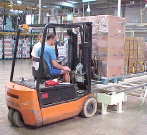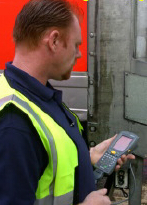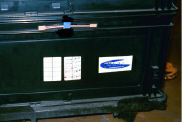May 5, 2003 – The great promise of radio frequency identification is that it can reduce costs across the supply chain. By sharing information on the amount and location of product, retailers, manufacturers and distributors can all reduce inventories, react more quickly to changes in demand signals and make sure goods are always where they needs to be.
But before RFID can be deployed across the supply chain, companies are going to need to find ways to use it internally to cut costs and improve their own efficiency. The goods news is there are plenty of opportunities, and it’s not hard to launch a project that will pay off within a year. The bad news is that starting a small project that can be expanded to cover an entire area of your operations and integrated with RFID systems in other operational areas is far more challenging.
In Part 4 of this Special Report (see The Importance of Vision), we explained why it was necessary for senior executives to look at their company as a whole and its position within supply chain. The goal is to draw up a flexible blueprint that allows you to automate one area of the business at a time. Think of it like you are building a hospital complex one wing at a time. Each one has to function independently, but it also work as part of the whole.
There are many choices that need to be made in small tactical projects — which hardware vendor to use, which frequency, which standard, which software and so on. These decisions should be made not just on the basis of what will work for an individual project, but what will work across the company and eventually across the supply chain.
At this early stage, it will be difficult to get every decision right. You might decide that one frequency or data structure on the tag is ideal for your application. A year from now, an industry body could propose the entire industry adopt something different. Compounding the problem is the limited number of systems integrators who can provide good advice. (For a list of integrators, visit our Vendor Directory.)
It’s important to talk to vendors about options, about how easy it is to upgrade readers to handle new standards and whether it’s possible to reconfigure middleware to handle different data structures. We recommend investing in multi-protocol, multi-frequency readers that can be upgraded to handle whatever tagging technology becomes dominant in your industry.
Each company will have to sort out these issues based on its own situation and needs. The purpose of this article is to look at areas where companies can begin deploying RFID successfully. That is, we want to identify areas where companies can get a return on investment while learning about what RFID can and can’t do, about integration issues, and about other aspects of a deployment that will become critical as you begin to implement the technology more widely.
ROI, of course, is influenced by hardware prices (not to mention software licenses and integration fees). This article looks at areas where experts and end users say you can get a return on investment today, with reader costs of $1,000 to $3,000 and tag costs of 50 cents to a dollar.
Manufacturers
We’ve organized this story by opportunities for manufacturers, retailers and distribution and logistics companies, but many of the suggestions can be applied to companies all along the supply chain. For instance, the first place to start looking for a good RFID project, whether you are in retail, manufacturing or distribution, is where you have reusable containers that you control within your organization.
“The whole value proposition there is about asset utilization,” says Lyle Ginsburg, managing partner for technology innovation in Accenture’s products operating group. “You don’t want to buy more than you need, and you want to get the most use out of each one. We’ve done the business cases, and we’ve done pilots for companies. It’s a no-brainer.”
When tracking these assets, it is not necessary to put a reader on every shelf where they will be stored. The aim to install readers at choke points or in ways that will enable you to get the information you need. Often, once this is done, you get other benefits, such as new insights into consumption patterns, or improvements in customer service or order accuracy.
Accenture worked with one consumer packaged goods manufacturer to tag containers of raw materials. The tags not only provided insights into where the containers were and what was in them, but also into how old the material was. Accenture advised the manufacturer to put tags in the floor at key locations. Two antennas were put on the forklifts — one underneath to read the tag in the floor and the other in the front to identify the item.
By using software to match the location of the tag in the floor to the product in the reusable container, the manufacturer was able to keep track of exactly where individual vats were being stored. The system sends instructions to the forklift operator via an onboard computer. If he goes to the wrong location or picks up the wrong container, the operator gets a warning. If the operator ignores those warnings, then the equipment locks up before the contents of the container can be mistakenly added in the manufacturing process.
“You can improve quality, reduce waste, boost productivity, and decrease write-offs of outdate products very easily with this kind of system,” says Ginsburg. “It’s a simple but elegant approach that can be applied to almost any manufacturing environment.”
Manufacturers may also benefit from tagging pallets and writing the contents of the pallet to the RFID tag. The big benefit here is that as the pallets are loaded into a container, you can create an electronic bill of lading. Since February, shippers sending goods to the US have been required to send an electronic bill of lading 24 hours before the ship leaves the foreign port. The government announced last week that it is stepping up enforcement of the rule, which has been an added expense for most companies. By tagging the pallets, you get visibility, while creating a automated way to comply with the law. And if you put an electronic bolt seal on the container, you’ll likely reduce theft as well.
Manufacturers also have regular disputes with retailers over what exactly was delivered. Often, the manufacturer is better off sending a retailer goods the retailers says it didn’t get, rather than trying to spend valuable resources tracking down what was actually shipped. By tagging cases of some high-value items, such as perfumes or makeup as pallets are being built, manufacturers can create an audit trail that makes it possible to provide retailers with hard evidence of what goods were delivered.
The tags can be read automatically as the pallet is being loaded onto a truck. The system can be set up to alert the forklift driver if he/she is loading the wrong pallet on the truck. The system automatically ensures that the retailer gets what it ordered. The manufacturer saves labor and reduces charge-backs, and it can even use the same technology to track damaged goods being returned. Again, bolt seals can help reduce theft, or at least help identify where theft is taking place.
Retailers
Retailers can get even more benefits by tracking goods from their own distribution centers to stores. That’s because there are more points where staff would normally scan bar codes. By eliminating the need to scan those bar codes, the retailer can reduce labor costs and improve data accuracy, which enables it to reduce inventories and expenses associated with errors.
Putting readers on dock doors and tagging pallets as they arrive from manufacturers and are cross-docked to retail stores is simple, especially when combined with a yard management system that allows you to direct trucks to specific doors with readers. ES3, a Keene, New Hampshire-based grocery distributor is doing this at its state-of-the-art distribution center in York, Penn. (see Vendors Team to Optimize DCs).
In DCs where the pallets are broken down and then reconstituted for shipping to stores, cases for more expensive items can be tagged. So, when the goods leave the DC, the retailer knows that the shipment matches the order. And when the goods are received at the back of the store, the cases can be scanned into inventory automatically as they move through portal readers.
If the cases are tagged, they can be read again as they are brought out onto the retail floor. The business case here depends on the value of the item, the cost of the tag and business issues associated with the product. Those who have done the business case say there is an ROI for items where the cases cost $35 or more, the tag cost is about 40 cents or less, and the item is often stolen or out of stock. In superstores, such Home Depot and Costco, the system of putting tags in the floor or on shelving racks and readers on forklifts can be used to keep track of exactly where pallets of goods are in the store. That provides better visibility and reduces time wasted looking for goods.
Theft reduction is another area where retailers can look for a return on investment or to boost the ROI of a project. Woolworths developed a system for tagging pallets, sealing the truck and tracking the truck with GPS technology (see Tracking Products to Thwart Thieves). The retailer has not yet released information about the reduction in theft, but it recently extended the test for six months, suggesting the initial results were encouraging. Given that 2 percent of sales are lost globally due to “shrinkage,” such systems can pay off handsomely.
At current tag prices, it’s difficult to get a return on investment from projects in which individual items are tracked with RFID. But it’s not impossible. Generally speaking, it makes sense to track high-value items that are often stolen. DVDs, music CDs, computer games and even lingerie can all be worth tagging if the system is able to increase order accuracy, reduce labor costs and cut the rate of theft.
Item-level tracking may also make sense for retailers of high-value goods that control their own supply chain, such as The Gap, Benetton, Marks & Spencer and others. Since they can put tags on at manufacturing and track items all the way through to the store, the labor savings from eliminating bar code scanning is more significant. And the improvement in data accuracy and supply chain visibility can increase sales by reducing out of stocks and improving the stores’ ability to stock goods according to the preferences of local customers.
The Gap ran a pilot at one store in Atlanta last year using RFID tags from Texas Instruments. The retailer saw sales rise by more than 5 percent because the company knew exactly what was in inventory and because sales staff were able to spend more time helping customers. Marks & Spencer is planning a similar pilot later this year (see EPC in Fashion at Marks & Spencer). And Home Depot has been testing a system for tracking special-order items to reduce the time staff spend trying to locate these items when customers come to pick them up.
Distributors
Distributors and logistics providers can run projects similar to some of those undertaken by retailers and manufacturers. But some logistics providers are mistakenly waiting until customers tag the items before they begin deploying RFID technology. Those that aren’t waiting are finding they can get an ROI today.
Lionize Logistics, a third-party logistics provider based in Atlanta, recently completed a pilot in which it put tags on photocopiers and other office equipment, as well as on boxes of office supplies when it picked up goods from suppliers. The company tracked the goods through to delivery. RFID technology cut the time it took to gather data as it unloaded a truck at its facilities from three hours to one. Even with buying tags for 45 cents, the company got a return on its investment (see RFID Lionized After Warehouse Pilot). And tote management company Beal Solutions is going to tag all of its reusable totes.
Associated Foods Stores of Salt Lake City installed a yard management system from WhereNet and OMI International at its 600-acre distribution center in Farr West, Utah. The system uses active (battery powered) RFID tags to automatically track the location and status of 400 trucks as they move through various stations in the yard. The system cost less than $1 million for hardware, software and integration. After the system went live, the company was able to eliminate two full-time administrative positions at the depot, and it slashed the number of tractors in the fleet to 67, from 120. As a result, the system paid for itself within the first year.
Distributors and logistics providers can also add value through RFID. Some companies with refrigerated trucks are using RFID tags with temperature loggers to guarantee that goods have been maintained at the right temperature while being shipped. Others are looking to combine RFID with satellite tracking to give customers visibility into exactly where shipments are at all times.
The key to these initial projects is to gain confidence that the technology works, that your processes can be adapted for RFID tracking and that the integration work can be done, so that data is handled properly by your enterprise applications. Once all those things are in place, companies can quickly begin increasing their ROI by working with partners.
For instance, a manufacturer delivering direct to retail stores can work with a retailer to automate the shipping and receiving process. Advanced shipping notices can automatically be triggered when pallets with RFID tags get loaded on a truck. Systems can also be set up so that as soon as the goods are received at the back of the store, the payment process begins automatically.
“The retailer doesn’t have to verify case counts, so he saves some labor,” says Peter Abell, director of research for AMR Research’s retail practice. “If he gets the 20 percent of suppliers who account for 80 percent of the volume, that’s a pretty significant labor reduction.”
Going a step further, the retailer and manufacturer can set up systems for sharing data. If the manufacturer knows what’s at the store and what’s being sold in near real time, then it can replenish stocks in a more timely way, while reducing its own safety stocks. And if the retailer has visibility into what’s in the manufacturer’s pipeline, the retailer can reduce its own inventory levels. Once these single store pilots prove the business case, RFID adoption can accelerate rapidly and the same systems are rolled out to other stores.





